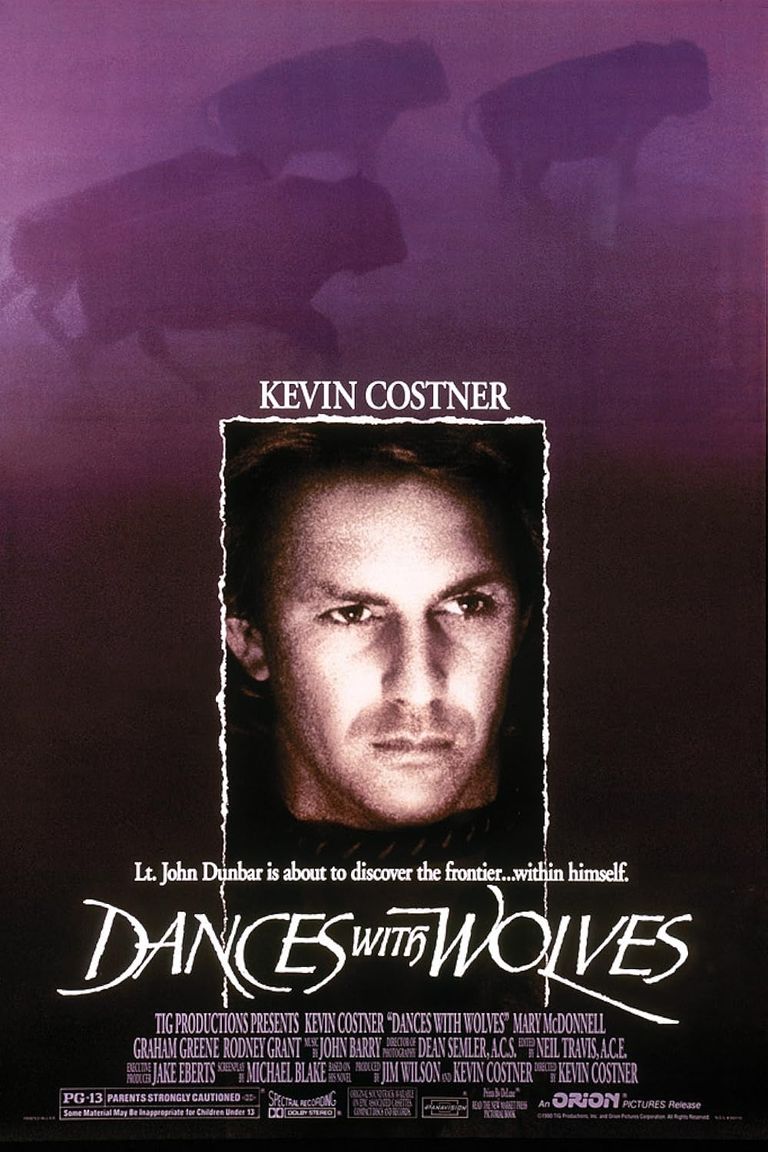
Dances with Wolves is a 1990 film directed, produced and starring Kevin Costner. The film is based on the novel of the same name by Michael Blake, who also wrote the screenplay.
The film won seven Academy Awards, including Best Picture and Best Director. In 2007, it was selected for preservation in the United States National Film Registry by the Library of Congress.
In 1998, the American Film Institute ranked it number seventy-fifth on its list of the one hundred greatest American films of all time.
Bailando con lobos tal como se la conoció en España o Danza con Lobos en Latinoamérica, es una película de 1990 dirigida, producida y protagonizada por Kevin Costner. La película está basada en la novela homónima de Michael Blake, quien también escribió el guión.
La película ganó siete premios Oscar, incluidos mejor película y mejor director. En 2007 fue elegida para ser preservada en el Registro Nacional de Películas de la Biblioteca del Congreso de Estados Unidos.
En 1998 el American Film Institute la situó en el puesto setenta y cinco de su ranking de las cien mejores películas americanas de todos los tiempos.

Kevin Costner: Lieutenant John Dunbar/ Dances With Wolves
Mary McDonnell: Raised Fist
Graham Greene: Kicking Bird
Rodney A. Grant: Wind In Your Hair
Robert Pastorelli: Timmons
Charles Rocket: Lieutenant Elgin
Maury Chaykin: Major Fambrough
Tony Pierce: Spivey
Wayne Grace: Major
Larry Joshua: Sergeant Bauer
Donald Hotton: General Tide
Tom Everett: Sergeant Pepper
Floyd 'Red Crow' Westerman: Ten Bears
Wes Studi: Pawnee Warrior Chief
Elisa Daniel: Christine's Mother
Annie Costner: Christine
Michael Horton: Captain Cargill
Jim Wilson: Surgeon Film Beginning
Kevin Costner: Teniente John Dunbar/ Baila con lobos
Mary McDonnell: Puño levantado
Graham Greene: Pájaro Kicking
Rodney A. Grant: Viento en tu cabello
Robert Pastorelli: Timmons
Charles Rocket: Teniente Elgin
Maury Chaykin: Mayor Fambrough
Tony Pierce: Spivey
Wayne Grace: Mayor
Larry Joshua: Sargento Bauer
Donald Hotton: General Tide
Tom Everett: Sargento Pepper
Floyd 'Red Crow' Westerman: Ten Bears
Wes Studi: Jefe guerrero Pawnee
Elisa Daniel: Madre de Christine
Annie Costner: Christine
Michael Horton: Capitán Cargill
Jim Wilson: Cirujano inicial de película

1863, during the Civil War. Lieutenant John Dunbar is an officer of the Union Army stationed in Tennessee. The man, who no longer wishes to do his duty, after a suicide attempt mistaken for an act of heroism, is mythologized and is granted the opportunity to choose the place where he can heal his wound and operate against rival soldiers: the lieutenant asks to be sent to a distant frontier garrison, on the edge of the Nebraska prairies.
Arriving at Fort Hayes, Ohio, Dunbar is sent by the mad commander of the garrison, Major Fambrouogh, to the most remote outpost of all, called Fort Sedgewick. Accompanied by the crude muleteer Timmons, he reaches the base, but finds it abandoned. After unloading the supplies from the wagon, Timmons returns to Fort Hayes, while Dunbar settles there. The suicide of Major Fambrouogh, committed shortly after Dunbar's departure, and the murder of Timmons by a group of Pawnee Indians, on the way back to Fort Hayes, determine the subsequent oblivion of Fort Sedgewick by the rest of the Army. John spends the first month working to restore the outpost to operational use, with only his horse Cisco for company, a wolf that watches him from the prairies (which he calls Two Socks, for his white paws) and his diary, in which he notes everything he sees and that happens to him.
The encounter with the neighboring tribe of Sioux Indians, fighting with the neighboring tribe of Pawnee (spies of the whites), will bring a new meaning to his life. The growing esteem and respect for this nomadic people and, last but not least, the love and marriage with Alzata Con Pugno, a white woman adopted by the tribe when she was a child (her parents were killed by the Pawnee, as well as her first Indian husband, when John meets her for the first time), will lead him to learn the Sioux language, to share problems and feelings of that people, to integrate into the life, traditions, customs and culture of the Indians, much better than the whites. He is accepted especially when, thanks to his guns, the Sioux easily kill all the Pawnee, including the chief, avenging the relatives of Alzata Con Pugno.
A dramatic clash with the Northern soldiers (his former comrades) convinces him to definitively erase his past as a soldier and a white man: he thus becomes Dances With Wolves, the name given by his adoptive Sioux "new family", in memory of his only company as a lone soldier at the fort, the wolf Two Socks. When Two Socks and Cisco are killed by the whites, John and the Sioux fight them and exterminate them.
Wanted and pursued as a traitor by the whites, he will be forced to abandon, together with his wife, what has become his people, but to avoid reprisals by the Yankees against the Sioux, they will also migrate with him to safety, far from the USA, in Canada.
1863, durante la Guerra Civil. El teniente John Dunbar es un oficial del ejército de la Unión estacionado en Tennessee. El hombre, que ya no quiere cumplir con su deber, después de un intento de suicidio confundido con un acto de heroísmo, es mitificado y se le da la oportunidad de elegir el lugar donde curarse de su herida y operar contra los soldados rivales: el teniente pide ser enviado a una guarnición fronteriza lejana, en el borde de las praderas de Nebraska.
Al llegar a Fort Hayes, Ohio, Dunbar es enviado por el loco comandante de la guarnición, el mayor Fambrouogh, al puesto de avanzada más remoto de todos, llamado Fort Sedgewick. Acompañado por el rudo arriero, Timmons llega a la base, pero la encuentra ahora abandonada. Después de descargar los suministros del carro, Timmons regresa a Fort Hayes, mientras Dunbar se instala allí. El suicidio del mayor Fambrouogh, cometido justo después de la partida de Dunbar, y el asesinato de Timmons por un grupo de indios Pawnee, en el camino de regreso a Fort Hayes, determinaron el posterior olvido de Fort Sedgewick por parte del resto del ejército. El primer mes John pasa trabajando para restaurar el puesto de avanzada, con la única compañía de su caballo Cisco, un lobo que lo observa desde las praderas (al que llama Two Socks, por sus patas blancas) y su diario, en el que anota. todo lo que ve y lo que le sucede.
El encuentro con la cercana tribu india Sioux, que lucha con la vecina tribu Pawnee (espías de los blancos), traerá un nuevo significado a su vida. La creciente estima y respeto por este pueblo nómada y, por último, pero no menos importante, el amor y matrimonio con Raised Fist, una mujer blanca adoptada por la tribu cuando era niña (sus padres fueron asesinados por los Pawnee, al igual que su primer marido). Indian, cuando John la conoce por primera vez), le llevará a aprender la lengua sioux, a compartir los problemas y sentimientos de ese pueblo, a integrarse en la vida, las tradiciones, las costumbres y la cultura india, mucho mejor que los blancos. Es aceptado especialmente cuando, gracias a sus armas, los sioux matan fácilmente a todos los Pawnee, incluido el jefe, vengando a los familiares de Raised With Fist.
Un dramático enfrentamiento con los soldados del Norte (sus antiguos camaradas) lo convence de borrar definitivamente su pasado de soldado y de hombre blanco: se convierte así en Danza con lobos, nombre que le dio su "nueva" familia adoptiva sioux, en memoria de El único que tiene su compañía como soldado solitario en el fuerte, el lobo Dos Calcetines. Cuando los blancos matan a Two Socks y Cisco, John y los sioux luchan y los exterminan.
Buscado y perseguido como traidor por los blancos, se verá obligado a abandonar, junto con su esposa, lo que se ha convertido en su pueblo, pero para evitar represalias de los yanquis contra los sioux, ellos también emigrarán con él a un lugar seguro, lejos de Estados Unidos, en Canadá.
The historical context. / El contexto histórico.
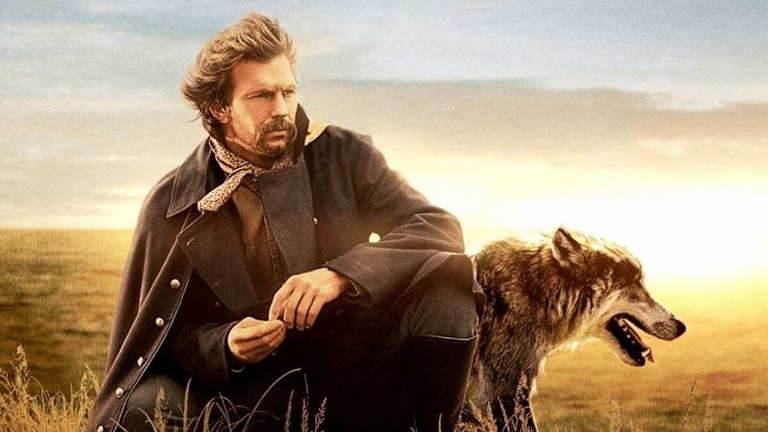
The film is set during the American Civil War. It is in fact at the end of this war that the American government begins the conquest of the West, invading and massacring the great native tribes of the American Plains, such as the Sioux, Cheyenne, Comanche and Apache.
It is precisely against these large tribes that the interest of hegemony and supremacy of the American army is concentrated. In particular, the conflict is centered on the desire to dominate the most warlike of these tribes: the Sioux (to which the Indians in the film belong). In the fifteen years between 1862 and 1877, the clashes between the Sioux and the American army will be intense.
In 1862 there was the first war against the Sioux who lived in the last eastern forests previously destroyed by usurpers from overseas. In 1866-1868 there was the first great war against the Sioux of the Plains, in particular against Chief Red Cloud. But it was in 1876-1877 that the great Sioux war of 1876 broke out (in particular against the tribal leaders Sitting Bull and Crazy Horse). In these two years the bloodiest battles took place, such as that of Little Big Horn. At the end of the conflict the remaining Sioux were forced to live on Indian reservations. The last rebels (including Sitting Bull himself) fled to Canada, only to surrender in 1880-1881 and settle on reservations themselves.
A final Sioux rebellion occurred in 1890, when a group of them, again led by Sitting Bull, fled the reservations because of the harsh rules and prohibitions imposed there. In December 1890 Sitting Bull was killed, and the last rebels were captured in January 1891.
La película tiene lugar durante la Guerra Civil estadounidense. De hecho, fue al final de esta guerra cuando el gobierno americano inició la conquista de Occidente, invadiendo y masacrando a las grandes tribus nativas de las llanuras americanas, como los sioux, cheyenne, comanches y apaches.
Es precisamente contra estas grandes tribus donde se concentra el interés del ejército estadounidense por la hegemonía y la supremacía. En particular, el enfrentamiento se centra en el deseo de dominar a la más guerrera de estas tribus: los sioux (a la que pertenecen los indios de la película). En los quince años transcurridos entre 1862 y 1877, los enfrentamientos entre los sioux y el ejército estadounidense fueron intensos.
En 1862 hubo la primera guerra contra los sioux que residían en los últimos bosques orientales previamente destruidos por usurpadores que venían de ultramar. En 1866-1868 tuvo lugar la primera gran guerra contra los sioux de las llanuras, en particular contra el jefe Nube Roja. Pero fue en 1876-1877 cuando estalló la gran guerra sioux de 1876 (en particular contra los jefes tribales Toro Sentado y Caballo Loco). Las batallas más sangrientas tienen lugar en este bienio, como la de Little Big Horn. Al final del conflicto, los sioux restantes se vieron obligados a vivir en reservas indias. Los últimos rebeldes (incluido el propio Toro Sentado) huyeron a Canadá, sólo para rendirse en 1880-1881 y establecerse en las propias reservas.
Una última rebelión de los sioux tuvo lugar en 1890, cuando un grupo de ellos, nuevamente liderado por Toro Sentado, huyó de las reservas debido a las duras reglas y prohibiciones impuestas en ellas. En diciembre de 1890 Toro Sentado cayó, fue asesinado y los últimos rebeldes fueron capturados en enero de 1891.
The social context. / El contexto social.
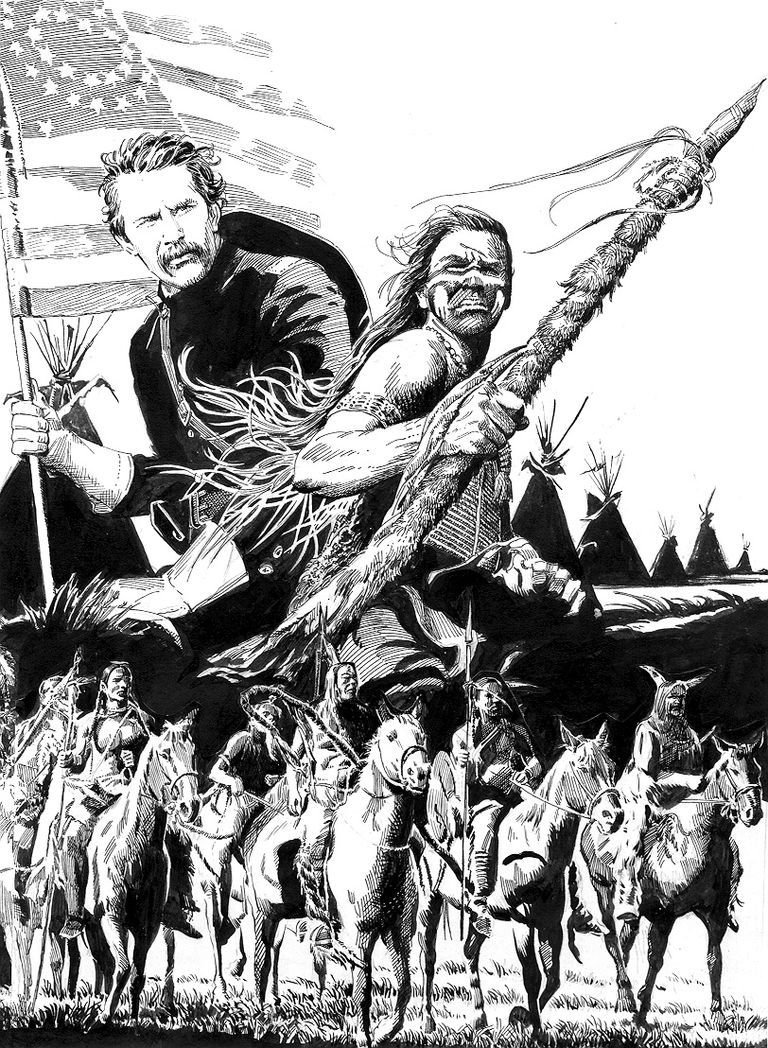
The Sioux are a people with their own language and traditions. At the time the film is set (i.e. in the two-year period 1863-1864), the Sioux were about twenty-five thousand, spread over a territory of over 350 thousand km² (approximately all the territory of today's North and South Dakota). They are divided into three main groups depending on where they lived and the dialect variants of their language: Dakota (who lived in the eastern forests), Nakota (who lived on the plains near the forests and to the north) and Lakota (who lived on the great plains of the Far West in a territory of about 200 thousand km²). Each of the three groups was divided into various tribes: four for the Dakota and Nakota and seven for the Lakota. The Lakota Sioux group was by far the most numerous and combative, while it was the Lakota who lived on the great plains of the Far West.
Each tribe was divided into several bands (from three to eleven per tribe, depending on the size of the tribe itself; on average about five to seven per tribe) who lived in separate places and camps. Each Sioux band had a chief. The different bands of the same tribe would gather once a year in the summer and during a war. Among the various band leaders, the most charismatic and authoritative would assume the "de facto" role of tribal chief. Among the most famous Sioux to hold this role were Sitting Bull, Crazy Horse and Red Cloud, all three belonging to the Lakota group. Each Sioux band consisted of about two hundred and fifty to three hundred people and fifty families, each of which had a teepee (tent). Sometimes, two or three bands of the same tribe or the same group would join together for short periods to hunt together or to wage war together against common enemy bands.
In summary, the Sioux people and society were composed as follows:
- a Confederation that brought together all the people (the Sioux precisely);
- three Nations (groups): Dakota, Nakota, Lakota;
- fifteen tribes: four Dakota, four Nakota, seven Lakota;
- seventy-five hundred bands.
The natives present in the film are a Lakota band[3] of one of the seven tribes of that group (it is not known exactly which one, since there is no clue in the film). The leader of the band is Ten Bears; the role of shaman is covered by Kicking Bird, while the leader-warrior of the same is Wind in the Hair.
Los sioux son un pueblo con su propia lengua y tradición. En el momento en que se desarrolla la película (es decir, en el bienio 1863-1864), los sioux eran alrededor de veinticinco mil, repartidos en un territorio de más de 350 mil km² (casi todo el territorio de los actuales Norte y Sur). Dakota). Se dividen en tres grupos principales según el lugar en el que vivieron y las variantes dialectales de su lengua: Dakota (que vivía en los bosques del este), Nakota (que vivía en las llanuras cercanas a los bosques y al norte) y Lakota (que vivía en las grandes llanuras del Lejano Oeste en un territorio de aproximadamente 200 mil km²). Cada uno de los tres grupos estaba dividido en varias tribus: cuatro para los Dakota y Nakota y siete para los Lakota. El grupo Lakota Sioux era, con diferencia, el más numeroso y combativo, mientras que eran los Lakota los que vivían en las grandes llanuras del Lejano Oeste.
Cada tribu estaba dividida en varios grupos (de tres a once por tribu, dependiendo del tamaño de la tribu misma; en promedio alrededor de cinco a siete por tribu) que vivían en lugares y campamentos separados. Cada banda sioux tenía un líder. Las diferentes bandas de una misma tribu se reunían una vez al año en verano y con motivo de una guerra. Entre los diversos líderes de las pandillas, los más carismáticos y autoritarios asumieron "de facto" el papel de líder tribal. Entre los sioux más famosos que desempeñaron este papel se encuentran Toro Sentado, Caballo Loco y Nube Roja, los tres pertenecientes al grupo Lakota. Cada una de las bandas sioux estaba formada por aproximadamente de doscientas cincuenta a trescientas personas y cincuenta familias, cada una de las cuales tenía un tipi (tienda de campaña). A veces, dos o tres bandas de la misma tribu o grupo se unían durante períodos cortos para cazar juntas o hacer la guerra juntas contra bandas enemigas comunes.
En resumen, el pueblo y la sociedad sioux estaban compuestos de la siguiente manera:
- una Confederación que reunía a todo el pueblo (los sioux precisamente);
- tres Naciones (grupos): Dakota, Nakota, Lakota;
- quince tribus: cuatro Dakota, cuatro Nakota, siete Lakota;
- setenta y quinientas bandas.
Los nativos presentes en la película son una banda Lakota[3] de una de las siete tribus de ese grupo (no se sabe exactamente cuál, ya que no hay ninguna pista al respecto en la película). El líder de la pandilla es Dieci Orsi; el papel de chamán lo desempeña Uccello Calciante, mientras que el líder guerrero del mismo es Vento nei Capelli.
Production. / Producción.
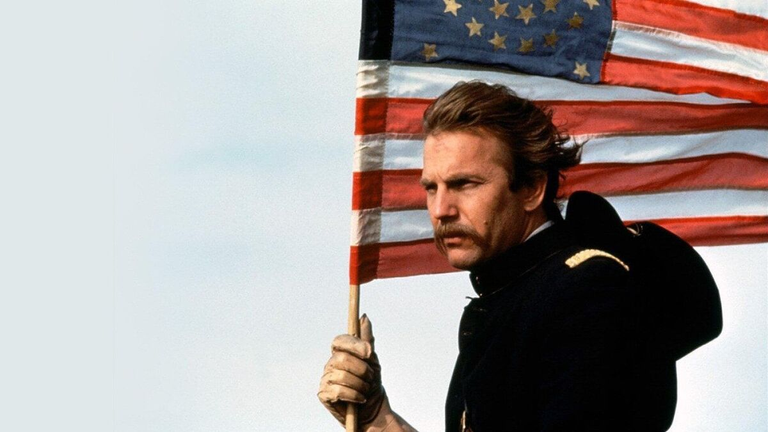
The film's story was written, largely at Kevin Costner's house by Michael Blake, between 1986 and 1988. The film was shot from July 18 to November 23, 1989. The film was released in U.S. theaters on October 19, 1990, while in Italy it was released on December 14.
Much of the filming took place in the Black Hills of South Dakota. Over one hundred and fifty extras were used to recreate the Indian tribe and nearly four hundred horses. A herd of 3,500 animals was used to film the scene of the passage of the tatanka (buffalo) on the prairie at the Triple U Buffalo Ranch. Twenty-four Indian actors on horseback were used. Two domesticated wolves were used for the scenes with the wolf "Two Socks".
The Indian camp location is on the Belle Fourche River in South Dakota. The winter Indian camp scenes were filmed at Spearfish Canyon, southwest of Latchstring Inn and Roughlock Falls. The main actors who play the Indians are not Sioux, so they had to take lessons in the Lakota language to shoot the film. In the scene where the settlers are massacred by the Pawnee Indians, Kevin Costner's wife and daughter (who plays Christine, future Raised With a Fist) appear. Doris Leader Charge (1931-2001) and actress Pretty Shield (Ten Bears' wife) were the references for reproducing the Sioux culture on the set.
The film's soundtrack was cited by Pope John Paul II as one of his favorite pieces of music.
La historia de la película fue escrita, en gran parte en la casa de Kevin Costner por Michael Blake, entre 1986 y 1988. La película se rodó del 18 de julio al 23 de noviembre de 1989. La película se estrenó en los cines de Estados Unidos el 19 de octubre de 1990, mientras que en Italia se estrenó el 14 de diciembre siguiente.
Gran parte del rodaje tuvo lugar en Black Hills, en Dakota del Sur. Se utilizaron más de ciento cincuenta extras para recrear a la tribu india y casi cuatrocientos caballos. Para filmar la escena del paso del tatanka (bisonte) a través de la pradera, se utilizó una manada de 3.500 animales en el Triple U Buffalo Ranch. Se utilizaron veinticuatro actores indios a caballo. Para las escenas con el lobo "Dos calcetines" se utilizaron dos lobos mansos.
La ubicación del campamento indio se encuentra en el río Belle Fourche en Dakota del Sur. Las escenas del campamento indio de invierno se filmaron en Spearfish Canyon, al suroeste de Latchstring Inn y Roughlock Falls. Los actores principales que interpretan a los indios no son sioux, por lo que tuvieron que tomar lecciones de idioma lakota para rodar la película. En la escena donde los colonos son masacrados por los indios Pawnee, aparecen la esposa y la hija de Kevin Costner (que interpreta a Christine, futura Raise With Fist). Doris Leader Charge (1931-2001) y la actriz Pretty Shield (esposa de Ten Bears) fueron los contactos para la reproducción de la cultura sioux en el plató.
La banda sonora de la película fue citada por el Papa Juan Pablo II como una de sus piezas musicales favoritas.
The planetary success. / Éxito planetario.
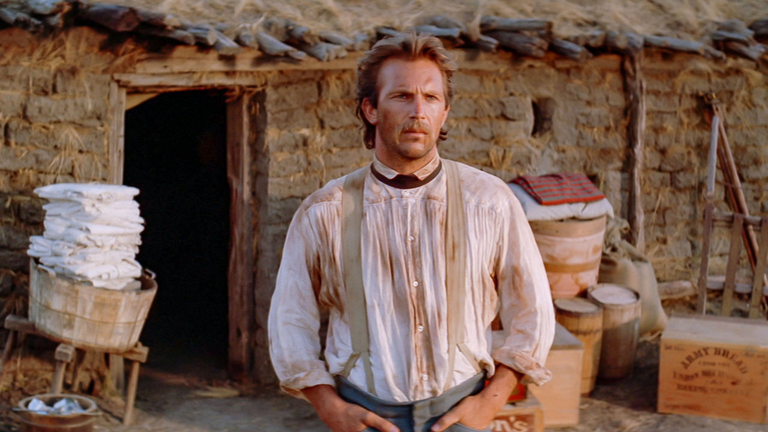
The film is set between late 1863 and 1864. The first scenes featuring Lieutenant John J. Dunbar engaged in the Civil War appear to take place in September-October 1863.[4] Lieutenant John J. Dunbar arrives at Fort Sedgwick in April 1864.[5][6] His history with the Indians lasts from May 1864.[7] until the beginning of the winter of the same year (November-December 1864).[8]
The film won a total of seven 1991 Academy Awards: "Best Picture", "Best Director", "Best Adapted Screenplay", "Best Cinematography", "Best Film Editing", "Best Original Score", "Best Sound Mixing". It also received the following nominations: "Best Actor in a Leading Role" (Kevin Costner), "Best Supporting Actor" (Graham Greene), "Best Supporting Actress" (Mary McDonnell), "Best Production Design" and "Best Costume Design". In addition to the Academy Awards, Costner's film also won three Golden Globes and received nine nominations for the prestigious BAFTA Awards.
On its first television broadcast, on Rai Uno, on March 1, 1993, the film recorded 14,554,000 viewers, one of the highest ratings (for a film) on Italian television, and is currently in fourth place after Roberto Benigni's Life is Beautiful (16,080,000 viewers on Rai Uno in 2001); The Name of the Rose (14,672,000 viewers on Rai Uno 1988); Rambo: First Blood Part II (14,580,000 viewers on Rai Uno in 1988). At the box office, in Italy Costner's film was a box office hit in the 1990-91 season with over 23 billion lire ahead of Pretty Woman and Disney's The Little Mermaid. In the USA, the film was also a box office success, grossing $184,208,848. Worldwide grosses were $424.2 million.
La película está ambientada entre finales de 1863 y 1864. Las primeras escenas que ven al teniente John J. Dunbar involucrado en la Guerra Civil tienen lugar en septiembre-octubre de 1863[4]. El teniente John J. Dunbar llega a Fort Sedgwick en abril de 1864[5][6]. Su historia con los indios duró desde mayo de 1864[7] hasta principios del invierno del mismo año (noviembre-diciembre de 1864)[8].
La película ganó un total de siete premios Oscar en 1991: "mejor película", "mejor director", "mejor guión no original", "mejor fotografía", "mejor montaje", "mejor banda sonora", "mejor sonido". Además, también recibió las siguientes nominaciones: "mejor actor protagonista" (Kevin Costner), "mejor actor de reparto" (Graham Greene), "mejor actriz de reparto" (Mary McDonnell), "mejor diseño de producción" y "mejor vestuario". Además de los premios Oscar, la película de Costner también ganó tres Globos de Oro y recibió nueve nominaciones a los prestigiosos premios BAFTA.
En su primera emisión televisiva, en Rai Uno, el 1 de marzo de 1993, la película atrajo a 14.554.000 espectadores, una de las mayores audiencias (para una película) de la televisión italiana, y actualmente ocupa el cuarto lugar después de La vita è bella de Roberto Benigni. (16.080.000 espectadores en Rai Uno en 2001); El nombre de la rosa (14.672.000 espectadores en Rai Uno 1988); Rambo II: la venganza (14.580.000 espectadores en Rai Uno en 1988). En Italia, la película de Costner fue un éxito de taquilla en la temporada 1990-91, con más de 23 mil millones de liras, por delante de Pretty Woman y La Sirenita de Disney. Incluso en Estados Unidos la película fue un éxito de taquilla, de hecho recaudó 184.208.848 dólares. Los ingresos brutos mundiales fueron de 424.200.000 dólares.
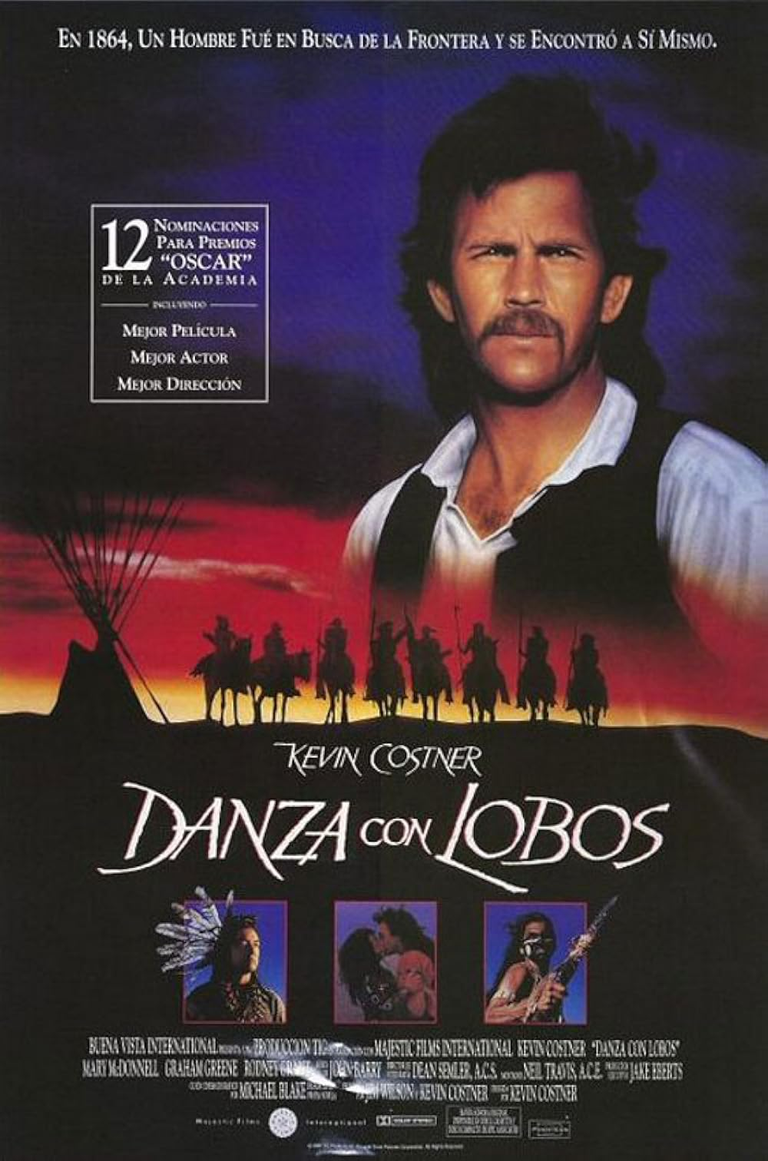


Credits for extracted images and screenshots of the trailer go to the IMDB site.
Credits for the final banner with the author's signature (modified with the freely distributed Kolour Paint program) go to Pixabay.
Los créditos por las imágenes extraídas y capturas de pantalla del trailer van al sitio IMDB.
Los créditos por el banner final con la firma del autor (modificado con el programa Kolour Paint de distribución libre y gratuita va a Pixabay.
Source images / Fuente imágenes: IMDB.

| Blogs, Sitios Web y Redes Sociales / Blogs, Webs & Social Networks | Plataformas de Contenidos/ Contents Platforms |
|---|---|
| Mi Blog / My Blog | Cine & Series de Cabecera. |
| Red Social Twitter / Twitter Social Network | @hugorep |

I remember watching that film. Sometimes the progressed like to leave "progress". The march spares neither than native nor the settler.
Re🤬eD
OP_MAN
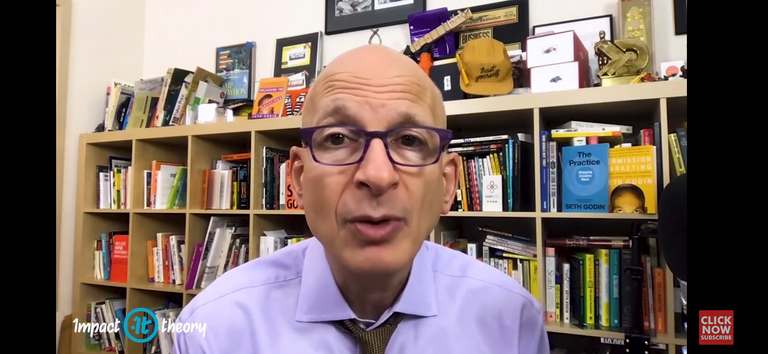
🤬
Thank you for your support @frankbacon.
High Regards

🥓
Have a nice Sunday!